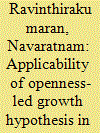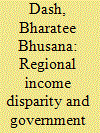|
|
|
Sort Order |
|
|
|
Items / Page
|
|
|
|
|
|
|
| Srl | Item |
| 1 |
ID:
136064


|
|
|
|
|
| Summary/Abstract |
An openness-led growth hypothesis investigates the causal relationship between trade openness1 and economic growth. Indeed, trade openness can stimulate economic growth by enhancing the international flow of knowledge and innovation and by allowing economies of specialization, not only in the production of goods, but also in the generation of new knowledge and new inputs into production. The purpose of this article is to empirically examine an openness-led growth hypothesis, using the case of Sri Lanka for the period from 1965 to 2012. The article uses the recently developed autoregressive distributed lag (ARDL) bounds test for cointegration developed by Pesaran et al. (2001). The empirical results confirm the validity of the openness-led growth hypothesis for Sri Lanka.
|
|
|
|
|
|
|
|
|
|
|
|
|
|
|
|
| 2 |
ID:
136060


|
|
|
|
|
| Summary/Abstract |
Like many other developing countries, South Asian nations have been experiencing increased foreign direct investment inflows over the past decade as developing countries get a larger share of cross-border investments that were once sent to developed countries. Nonetheless, South Asia’s inflows of foreign direct investment remain the lowest relative to gross domestic product among developing country regions. Why are South Asia’s foreign direct investment inflows so low and what lessons can be drawn for developing countries as a whole? The analysis in this article uses a novel empirical model that accounts for possible trends in convergence in the ratio of foreign direct investment to gross domestic product between countries and cross-sectional data for 78 countries from 2000 to 2011. The sample contains 52 developing countries. The analysis finds that two key factors are at work—high overall regulatory restrictions on foreign direct investment and specific restrictions placed on doing business with other countries. These factors include overall trade restrictiveness, which reduces the benefits to cross-border investments, and weak institutions to protect foreign investors and facilitate investment. Nonetheless, the potential for faster growth in intra- and inter-regional foreign direct investment flows is significant. The main factors leading to this conclusion are South Asia’s current low levels of foreign direct investment, the many unexploited opportunities for embodied knowledge transfer, and supply-chain linkages. The overall lessons for developing countries are that liberalizing policy constraints in both trade and foreign investment, keeping corporate tax rates modest, and improving governance and transparency could help to substantially improve foreign direct investment flows.
|
|
|
|
|
|
|
|
|
|
|
|
|
|
|
|
| 3 |
ID:
136065


|
|
|
|
|
| Summary/Abstract |
Net interest margin (NIM) is an indicator of the level of efficiency of financial intermediation by banks. This study analyses the determinants of NIMs of domestic banks of Sri Lanka for the period of January 2002 to March 2011 based on the model developed by Ho and Saunders and its extensions using panel regression. Sri Lankan banks are inward looking in setting NIMs as operating costs, credit risk, risk aversion, non-interest income and capital adequacy requirements are determinants. Market competition, other regulations on banks, risk arising from the volatility of market prices and macroeconomic variables do not have a significant impact on the determination of NIMs.
|
|
|
|
|
|
|
|
|
|
|
|
|
|
|
|
| 4 |
ID:
136063


|
|
|
|
|
| Summary/Abstract |
Despite of the fact that poverty is one of the major issues concerning policy makers, it has received less attention with respect to its linkages with services sector growth. In this research study, an attempt was made to quantitatively explore the nexus between growth in services sector of Pakistan and its poverty reducing impact. A time series data ranging from 1951 to 2010 were used in this study. The services sector was disaggregated into six sub-sectors. An Augmented Dickey–Fuller test was applied to check the stationarity of the data. An Auto-Regressive Distributed Lag approach to co-integration and error correction model was applied to estimate long- and short-run coefficients, respectively. The results of the study indicate that growth in wholesale and retail trade and the ownership of dwelling reduce poverty only in the short run. Growth in finance and insurance worsen poverty. The greatest impacts on poverty reduction occur as result of growth in community services (CS) and transportation, storage and communication (TSC). Among all variables, community services were found highly significant with the coefficients 0.62 and 0.308 in the long run and short run respectively. Therefore, it was concluded that relatively more stress should be given on community services such as education, and health, etc., in order to reduce poverty in Pakistan.
|
|
|
|
|
|
|
|
|
|
|
|
|
|
|
|
| 5 |
ID:
136062


|
|
|
|
|
| Summary/Abstract |
An open border, a pegged exchange rate regime and large trade with India offer Nepal some preconditions to satisfy monetary integration with its southern neighbour. In this study, investigation of the economic symmetry in the two countries is considered. A two-pronged empirical approach reveals inconclusive evidence to satisfy such integration. First, using a three-variable structural vector auto-regression showed a low and negative correlation in the supply shocks. Decomposing the structural shocks into regional and idiosyncratic components showed a favourable co-movement with the regional element only in Nepal’s monetary shock. Second, the business-cycle analysis using state-space models of Nepal’s GDP and its components showed evidence of co-movement with the regional element in some variables while others showed divergence.
|
|
|
|
|
|
|
|
|
|
|
|
|
|
|
|
| 6 |
ID:
136066


|
|
|
|
|
| Summary/Abstract |
This study examines the relationship between the fiscal intervention of the government and regional income disparity in 14 major Indian states. The impact of decentralization on the regional disparity of these states is also examined. The findings suggest that both policy measures have reduced the level of regional disparity. This study has also investigated the impacts of policy measures on regional income disparity within the clusters of states of similar income levels. Results suggest that both types of policy interventions have reduced regional disparity in low-income states, whereas only fiscal intervention is found significant in reducing regional disparity in middle-income states. Surprisingly, no relation is found between regional disparity and the policy measures in high-income states.
|
|
|
|
|
|
|
|
|
|
|
|
|
|
|
|
| 7 |
ID:
136061


|
|
|
|
|
| Summary/Abstract |
This article examines the gains for South Asian economies from integrating with East Asia and India’s role in this process. Evidence of increased pan-Asian integration exists but the process is uneven. Bilateral trade has grown. Bilateral foreign direct investment flows and free trade agreements (FTAs) have also increased, albeit at a slower pace than trade. The integration process has been led by India and Pakistan with limited participation of smaller South Asian economies. Tackling key impediments in infrastructure, FTAs, trade barriers and business regulations, and barriers to services will foster further integration. Computable general equilibrium simulations suggest that a South Asia–East Asia FTA offers the most gains for South Asia and that India has an incentive to include its neighbours in such an arrangement rather than going it alone with East Asia. The rest of South Asia will gain by deepening South Asian integration and fostering ties with East Asia.
|
|
|
|
|
|
|
|
|
|
|
|
|
|
|
|
|
|
|
|
|